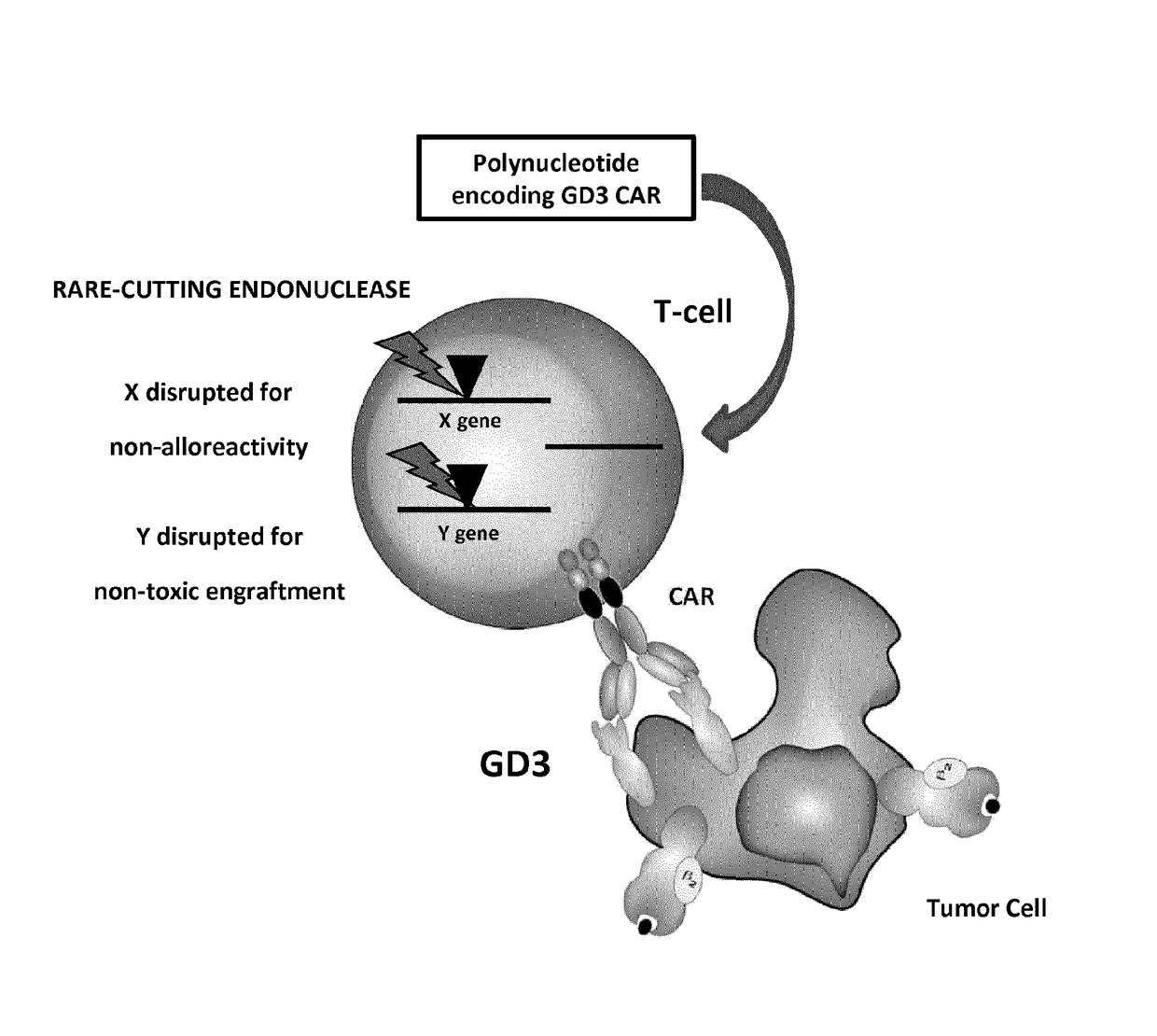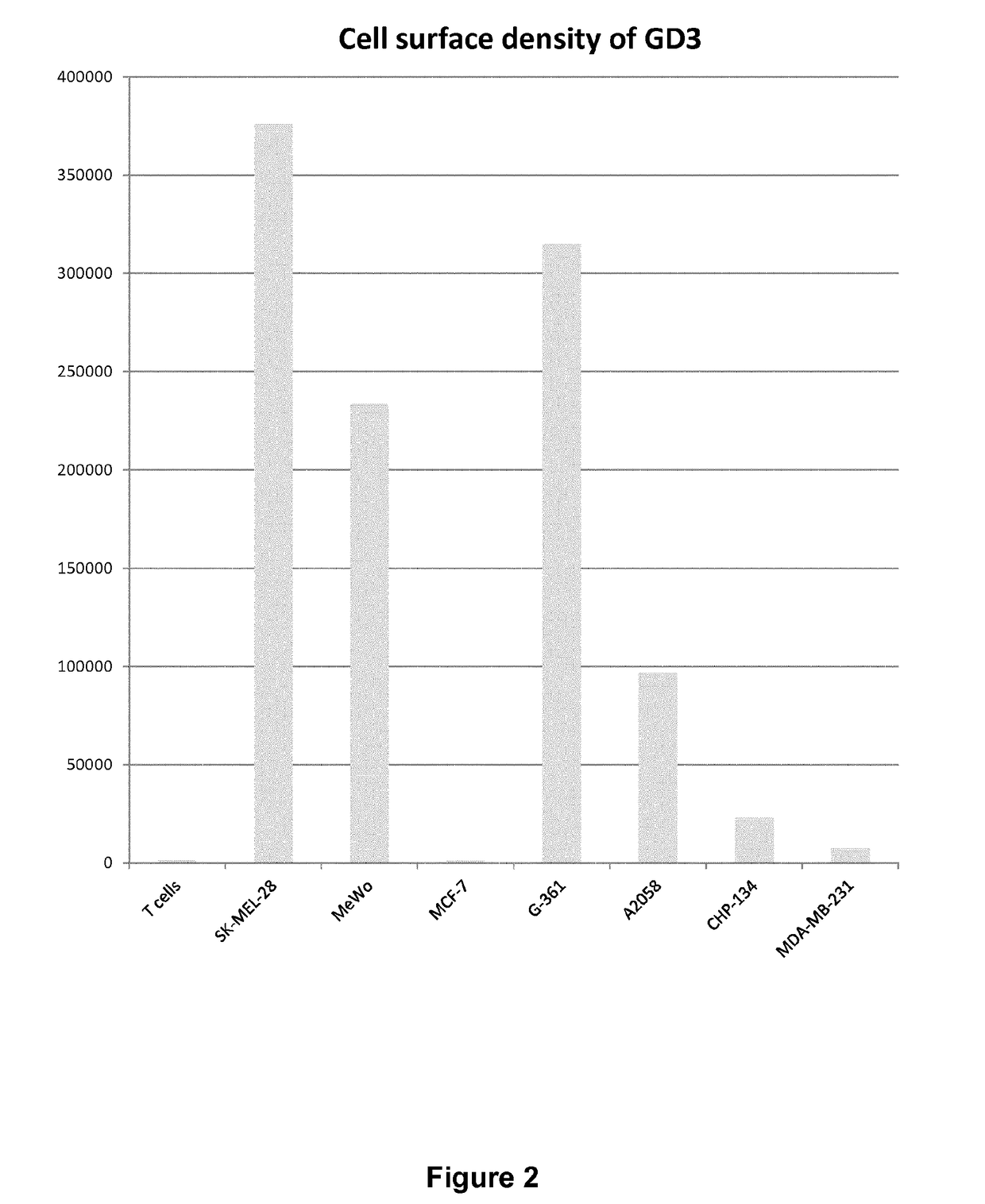Anti-gd3 specific chimeric antigen receptors for cancer immunotherapy
a chimeric antigen receptor and cancer immunotherapy technology, applied in the field of chimeric antigen receptors, can solve the problems of inability to provide prolonged expansion and anti-tumor activity in vivo, inability to expand to any antigen, and low expression level of gangliosides in general and gd3 in particular
- Summary
- Abstract
- Description
- Claims
- Application Information
AI Technical Summary
Benefits of technology
Problems solved by technology
Method used
Image
Examples
example 1
of GD3-Positive and -Negative Cell Lines
[0180]Materials and Methods
[0181]Primary Cells
[0182]Peripheral blood mononuclear cells were isolated by density gradient centrifugation from buffy coats from healthy volunteer donors (Etablissement Francais du Sang). T lymphocytes were then purified using the EasySep human T cell enrichment kit (Stemcell Technologies), and activated with Dynabeads Human T-Activator CD3 / CD28 (Life Technologies) in X-vivo 15 medium (Lonza) supplemented with 20 ng / ml IL-2 (Miltenyi) and 5% human AB serum (Seralab).
[0183]Cell Lines
[0184]The SK-MEL-28, A2058, G-361, MeWo and MCF-7 cell lines were obtained from the American Type Culture Collection. MeWo and SK-MEL-28 cells were cultured in EMEM supplemented with 10% heat—inactivated FCS, 2 mmol / L L-glutamine and 100 units / ml penicillin, and 100 μg / mL streptomycin. A2058 cells were cultured in DMEM supplemented with 10% heat—inactivated FCS, 2 mmol / L L-glutamine and 100 units / ml penicillin, and 100 μg / mL streptomycin...
example 2
n of Anti-GD3 scCARs
[0191]In these experiments were designed twelve 2nd generation anti-GD3 specific scCARs resulting from the fusion of the building blocks as depicted in the FIG. 4.[0192]one scFv from murine (MB3.6 or KM641 or BW2121 or R24) origin[0193]one spacer (human FcεRIIIα hinge or human CD8a hinge or human IgG1 hinge CH2 CH3)[0194]the transmembrane domain of human CD8α[0195]the costimulatory domain of human 41BB[0196]the activation domain of human CD3ζ
[0197]Different scFv were used in the scCARs to generate receptors of different binding affinities and different epitope specificities.
[0198]Three spacers of different length (16 aa, 45 aa and 231 aa) were used in the scCARs to try to optimize scCAR engagement by both proximal and distal epitopes of GD3 (Guest et al., 2005; Hudecek et al., 2013).
[0199]Materials and Methods
[0200]Synthesis of DNA Encoding scCARs
[0201]The DNA encoding the scCARs was synthesized by GenScript.
[0202]Construction of In Vitro Transcription mRNA Vecto...
example 3
Testing of Anti-GD3 scCARs
[0210]Materials and Methods
[0211]RNA In Vitro Transcription
[0212]mRNA encoding the scCAR were in vitro transcribed and polyadenylated using the mMessage mMachine T7 Ultra kit (Life technologies) following the manufacturer's instructions. RNAs were purified with RNeasy columns (Qiagen), eluted in cytoporation medium T (Harvard Apparatus), and quantified by measuring absorbance at 260 nm using a Nanodrop ND-1000 spectrophotometer. Quality of the RNA was verified on a denaturing formaldehyde / MOPS agarose gel.
[0213]RNA Electroporation of T Cells
[0214]4-5 days or 11-12 post-activation, T lymphocytes were transfected by electrotransfer of messenger RNA using an AgilePulse MAX system (Harvard Apparatus). Following removal of activation beads, cells were pelleted, resuspended in cytoporation medium T at 25×106 cells / ml. 5×106 cells were mixed with 15 μg of the mRNA encoding the scCAR into a 0.4 cm cuvette. The electroporation consisted of two 0.1 ms pulses at 1200 ...
PUM
| Property | Measurement | Unit |
|---|---|---|
| Fraction | aaaaa | aaaaa |
| Electrical resistance | aaaaa | aaaaa |
| Surface | aaaaa | aaaaa |
Abstract
Description
Claims
Application Information
 Login to View More
Login to View More - R&D
- Intellectual Property
- Life Sciences
- Materials
- Tech Scout
- Unparalleled Data Quality
- Higher Quality Content
- 60% Fewer Hallucinations
Browse by: Latest US Patents, China's latest patents, Technical Efficacy Thesaurus, Application Domain, Technology Topic, Popular Technical Reports.
© 2025 PatSnap. All rights reserved.Legal|Privacy policy|Modern Slavery Act Transparency Statement|Sitemap|About US| Contact US: help@patsnap.com



